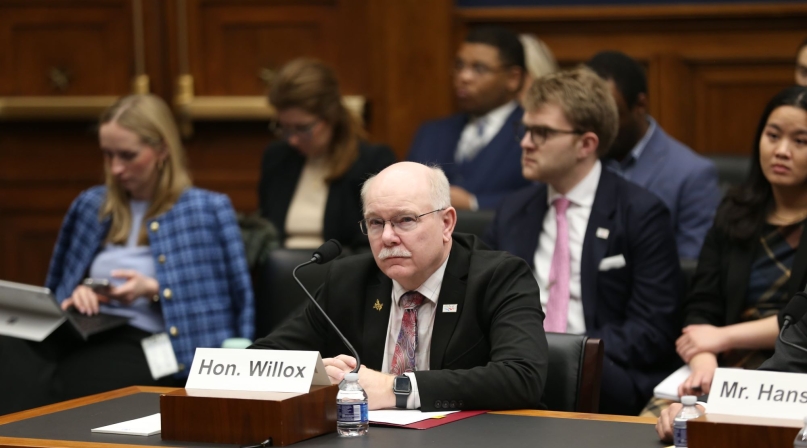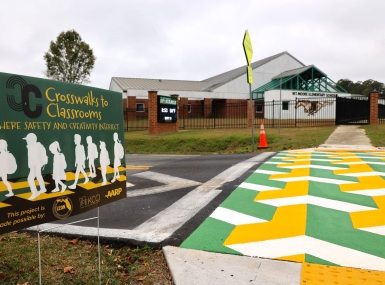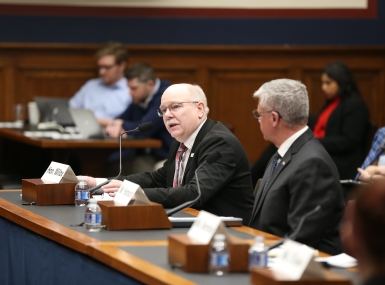Wyoming county commissioner stresses flexibility in transportation funding to House subcommittee

Key Takeaways
To improve rural road safety across the country and better serve local communities’ specific needs, Congress must afford counties more flexibility in how funds can be spent in the 2026 surface transportation reauthorization, Converse County, Wyo. Commissioner Jim Willox testified, on behalf of NACo, before the U.S. House Subcommittee on Highways and Transit on Feb. 12.
“What works in Wyoming, doesn't work in Texas, doesn't work in Florida,” Willox said at the “America Builds: A Review of Programs to Address Roadway Safety” hearing. “So, more flexibility in those dollars, so that we can be more creative at the local level and accountable … would be beneficial.”
Counties own or operate 44% of public roads and 38% of bridges. In Wyoming, counties own over 14,000 miles of road, 96% of which are categorized as rural. Rural communities have unique challenges and needs when it comes to transportation safety; they often rely on non-traditional infrastructure, such as lane bridges and gravel roads, which present safety concerns, said Willox, who serves as vice chair of NACo’s Transportation Committee.
Converse County needs dust control to keep its roads safe, which isn’t eligible under the current surface transportation funding framework, as it’s categorized as an environmental control and not a safety control, Willox added — emphasizing the need for more flexibility in reauthorization funding.
“In my county, we are larger than the state of Rhode Island, and we have over 500 miles of gravel roads,” Willox said. “When it comes to road safety, you may think of rumble strips or center lines, but neither of those are good options on gravel. Instead, gravel roads need dust suppression, longer culverts and regular blading to avoid washboarding [which causes ripples in gravel roads, making them dangerous to drive on].
“This is an area where I believe the government can do more to support rural communities by empowering local leaders to implement safety strategies that work for them.”
The nation’s “broken permitting system” creates additional challenges for counties, particularly in western rural communities, which usually have larger federal oversight due to public lands, Willox said. Converse County currently needs to reduce, grade and pave an existing gravel road, but because of the extensive US Forest Service and BLM permitting and review process, the project is being delayed for another year, he said.
“Before counties can begin many infrastructure projects, you must navigate a maze of federal permits,” Willox said. “… The standard permitting processes under NEPA can be costly, complex and time consuming. By streamlining permitting, even by just increasing the categorical exclusions, Congress could enable rural counties to take on more projects with less money.”
One of the biggest challenges rural communities face in road safety is having limited tax bases, which makes it more difficult to raise revenue for infrastructure projects, Willox said.
“With restricted financial capacity, county officials must often make the hard decision between choosing between a safety project or regular maintenance of another mile of road,” Willox said.
In order to make roads safer, counties need the ability to receive both direct funding for regular maintenance and ongoing activities and grant funding for bigger projects, Willox said.
“If we don't have the eligibility and the ability to go after grants that can help us with the large projects, many small, underpopulated or underfunded counties won't have the opportunity to do those projects that are larger in scale, that can be funded through their grant method,” Willox said. “Direct funding is wonderful, but if you're a small county with a small population, the formulistic number is going to be smaller.
“A blade costs half a million dollars now. If the formula gives you $100,000, that's still five years to gather it up … so I think the blend [of grant and direct funding] is what's important.”
To keep roads and residents safe, the whole system has to work, and county roads are a vital part of that — “nothing gets from ‘Point A to Point B’ without leaving the federal road system and crossing a county or city street and bridge,” Willox said. In his closing statement before the U.S. House Subcommittee on Highways and Transit, Willox shared the path his fellow Converse County commissioner, who is also a cattle rancher, takes to sell his cattle at the market, to emphasize how essential partnership at all levels of government is in strengthening the nation’s infrastructure.
“In order for him to get his cattle to market, he must travel across a series of roads — six miles of county gravel road, five miles of paved county road, three miles of a state highway, 68 miles of the interstate, 49 miles of a US Highway, finally into a city street to deliver the cattle to market,” Willox said. “To ensure road safety, there cannot be a weak link in that network. The interstate can be lined with pillows and mattresses, but if the county roads are unsafe, we have not done enough to keep our road users safe.”
Related News

County promotes traffic safety with colorful crosswalks
Leon County, Fla., created elevated, colorful crosswalks to decrease speeding and increase pedestrian safety.

Rep. Sam Graves: ‘Compromise’ will get it done
The House Transportation and Infrastructure Committee chairman said the upcoming surface transportation reauthorization will focus on traditional infrastructure.

NACo testifies in front of Congress on rural road safety
On February 12, Converse County, Wyo. Commissioner Jim Willox will be testifying on behalf of NACo before the U.S. House Subcommittee on Highways and Transit at a hearing titled “America Builds: A Review of Programs to Address Roadway Safety.”
Advocacy
NACo advocacy: Protecting county infrastructure by opposing heavy trucks legislation
Counties across the nation face pressing challenges as proposed legislation threatens to increase the size and weight of heavy trucks beyond the current 80,000-pound federal threshold. As owners of nearly half of all public road miles and one in four bridges in America, this issue significantly impacts county budgets and the safety of our residents.

